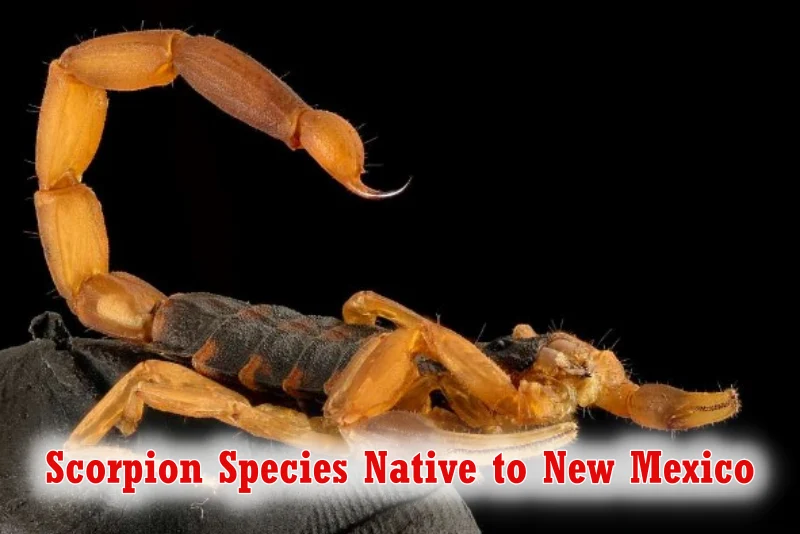Tangy salsa and tangoing with tiny arachnids are the new ways to go about Mexico!
Along with its vibrant culture and heritage, Mexico is home to many species, both venomous and non-venomous.
While it is home to one of the most venomous species of scorpions, the Arizona Bark Scorpion, one might mistakenly think the place is a haven for poisonous creepy crawlies, but one couldn’t be more wrong!
Out of the known species found in Mexico, only Arizona Bark Scorpions are known to pose a threat to humans.
Here, we have for you a comprehensive list of different scorpion species found in Mexico!
Scorpion Species Native to New Mexico
|
Scorpion Species Native to New Mexico |
|
| Name | Scientific Name |
| Striped bark scorpion | Centruroides vittatus |
| Giant desert hairy scorpion | Hadrurus arizonensis |
| Arizona bark scorpion | Centruroides sculpturatus |
| Giant whip scorpion | Mastigoproctus giganteus giganteus |
| Book scorpions | Pseudoscorpiones (order) |
| Guadalupe Mountains scorpion | Diplocentrus peloncillensis |
| Stripe-tailed scorpion | Paravaejovis spinigerus |
| Tailless whip scorpions | Amblypygi (order) |
| Eastern sand scorpion | Paruroctonus utahensis |
| Northern scorpion | Paruroctonus boreus |
| Lesser stripetail scorpion | Chihuahuanus coahuilae |
| Cash’s Scorpion | Vaejovis cashi |
10 New Mexico Scorpions
1) Book scorpions

| Scientific Name | Chelifer cancroides |
| Size | 2.5–4.5 mm |
| Identification | Tear-drop-shaped mahogany body |
| Habitat | Under the bark of trees, in bird nests and bee nests, and riding on bats |
| Dangerous To Humans | No |
Also known as the house pseudoscorpion, it is a species of pseudoscorpion that is completely harmless to humans.
While it possesses venomous pedipalps, these tiny scorpions do not pose any threat to human health.
The venom contained in these pedipalps is potent against various organisms, including bacteria, fungi, arthropods, and even mammalian cells.
This venom serves as a means of defense and immobilization for its prey, aiding in capturing and consuming its food.
2) Arizona bark scorpion
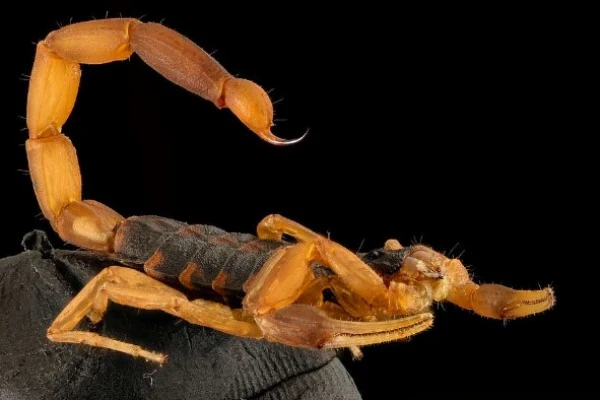
| Scientific Name | Centruroides sculpturatus |
| Size | 7- 8 cm |
| Identification | Small light brown scorpion |
| Habitat | Under rocks, wood piles, or tree bark and areas with well-moisturized soil |
| Dangerous To Humans | Yes |
By far the most venomous scorpion species in North America! Its venom contains potent neurotoxins that can induce severe pain, numbness, tingling, vomiting, and temporary dysfunction in the area stung in adult humans.
Though fatalities are rare, the discomfort from the bite can persist for 24-72 hours.
Due to the significant medical threat posed by its venom, an antivenin was developed in Mexico in 2011, Anascorp, which received FDA approval and is now used to treat stings.
It is hence important to take precautionary measures when roaming the streets of Mexico, including cleaning the sting site, applying a cool compress, and taking pain relievers like acetaminophen or ibuprofen.
3) Stripe-tailed scorpion
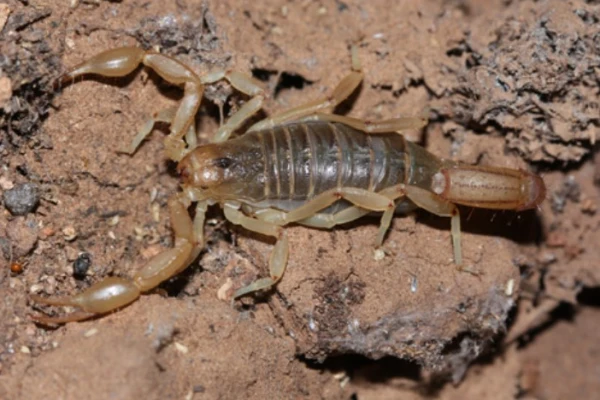
| Scientific Name | Paravaejovis spinigerus |
| Size | 60–70 mm |
| Identification | Scorpion with brownish-tan stripes on its back |
| Habitat | Humid areas |
| Dangerous To Humans | No |
Stripe-tailed scorpion is known to possess mild toxins that can cause swelling in humans.
While its sting can cause localized pain, swelling, and redness, the effects are generally not severe and are comparable to a bee sting.
Due to its venom and feeding habits, the Stripe-tailed Scorpion plays a crucial ecological role by controlling populations of insect pests and maintaining the ecological balance.
These medium-sized arachnids display a unique mating behavior.
Mating involves a combination of chemical signals and tactile communication, with males and females engaging in courtship dances.
Then the female scorpions carry their offspring on their backs until they have undergone their first molt.
4) Northern scorpion
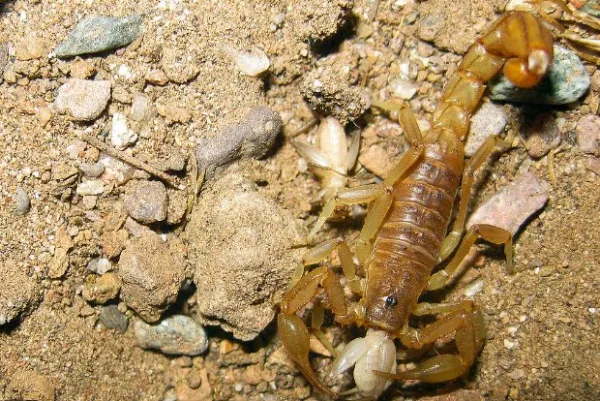
| Scientific Name | Paruroctonus boreus |
| Size | 35.5- 38.9 mm |
| Identification | Medium-sized yellow and black colored scorpion |
| Habitat | Often seen in rocky and sandy soil |
| Dangerous To Humans | No |
Northern scorpion possesses venom that is generally mild and not dangerous to humans.
Like the other scorpions we discussed above its sting can be painful, causing localized swelling and discomfort like a bee sting.
Northern Scorpion is known for its exceptional cold tolerance, making it the most cold-tolerant scorpion in New Mexico, and even extending into Canada!
Despite its fearsome appearance, the Northern Scorpion plays an important ecological role as a predator just like the Stripe-tailed scorpion
5) Striped bark scorpion
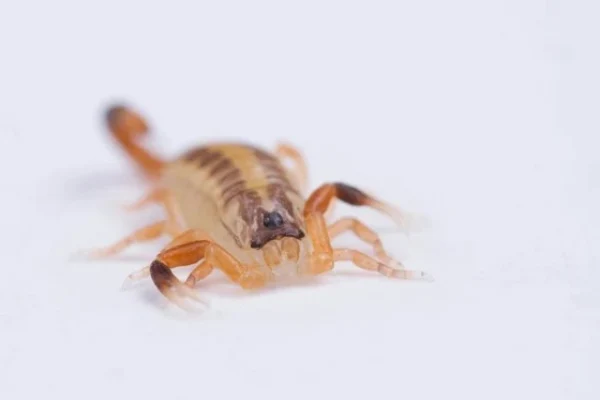
| Scientific Name | Centruroides vittatus |
| Size | 70 mm (maximum) |
| Identification | Pale yellow body with two black stripes |
| Habitat | Widely distributed – from deciduous forests to deserts |
| Dangerous To Humans | Yes |
Striped bark scorpion possesses a venomous sting that can be painful and cause localized swelling in humans.
While the sting is generally not life-threatening, like most of the scorpions it can induce discomfort and an inflammatory response at the site of the sting.
Its venom has neurotoxins that can affect sensory neurons responsible for pain perception, resulting in heightened sensitivity at the sting site.
Some individuals can experience an allergic reaction due to the venom resulting in angioedema (swelling of deeper layers of the skin), chest tightness, vomiting, wheezing, and, in severe cases, anaphylactic shock.
Hence it is important to exercise caution and seek medical care if stung.
6) Giant whip scorpion
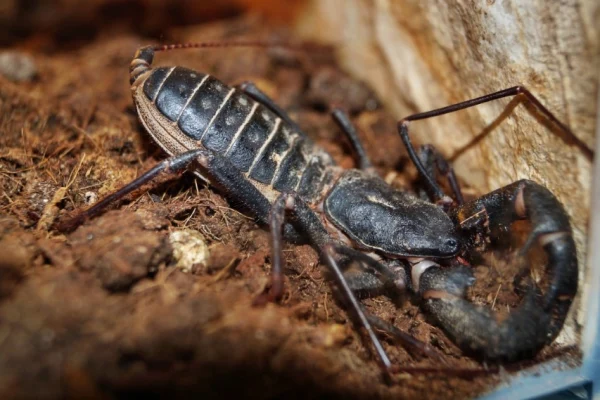
| Scientific Name | Mastigoproctus giganteus |
| Size | 40–60 mm |
| Identification | Scorpion with 8 eyes |
| Habitat | Resides at elevations up to 6000 ft. |
| Dangerous To Humans | No |
The Giant Whip Scorpion, also known as the giant vinegaroon, is a non-venomous species.
Unlike the other scorpions, it lacks a venom-filled stinger as a means of defense or prey immobilization.
Instead, it relies on its claws and other defensive mechanisms to evade its predators and catch prey.
When threatened it releases a foul-smelling substance, composed mainly of acetic acid (a chemical that gives vinegar its distinct smell) from glands located on its abdomen.
Due to their docile nature and unharming behavior towards humans, they are sometimes kept as pets in the exotic animal trade.
7) Tailless Whip Scorpion

| Scientific Name | Phrynus operculatus |
| Size | 18–22 mm |
| Identification | Medium-sized chestnut-colored scorpion |
| Habitat | Under rocks and cacti |
| Dangerous To Humans | No |
The Tailless Whip Scorpion, also known as the whip spider, is completely non-toxic to humans and like the Giant Whip, it lacks venom glands and does not possess the capability to deliver a harmful bite or sting to humans.
They use their long, whip-like front legs to capture and restrain their small prey.
When attacked or threatened they emit a spray of acetic acid, which has a pungent odor resembling vinegar.
8) Lesser stripetail scorpion
| Scientific Name | Chihuahuanus coahuilae |
| Size | 35–45 mm |
| Identification | Yellow and brown body with 4 stripes under its tail |
| Habitat | Burrowing species that prefer sandy soil |
| Dangerous To Humans | No, but the sting can be painful |
Despite its relatively small size the Lesser Stripe tail Scorpion possesses a venomous sting that can deliver a painful sensation to humans.
The sting typically results in a sensation of pain, sensitivity, and discomfort that can last for around 15 to 30 minutes, occasionally longer though no severe medical side effects have been reported.
Their primary defense mechanism is not inflicting the sting but rather standing in a defensive posture.
9) Giant desert hairy scorpion
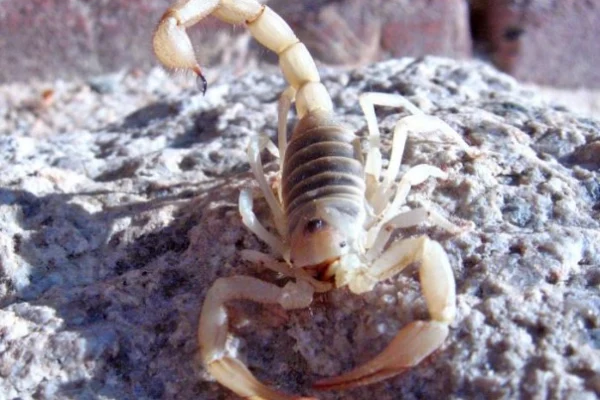
| Scientific Name | Hadrurus arizonensis |
| Size | ~14 cm |
| Identification | Yellow body with brown hair |
| Habitat | Adapted to hot and dry conditions, hence prefers deserts |
| Dangerous To Humans | Sting compared to that of a bee |
The Giant Hairy Desert Scorpion possesses venom that is not highly potent to humans.
Its sting is usually compared to a honeybee’s sting. While the sting can be uncomfortable, it is generally not considered a medical emergency.
Some individuals may exhibit allergic reactions showing symptoms such as difficulty breathing, excessive swelling, and prolonged pain.
10) Eastern sand scorpion
| Scientific Name | Paruroctonus utahensis |
| Size | ~6 inches |
| Identification | Yellow and brown body |
| Habitat | Loose sandy soil |
| Dangerous To Humans | No |
Like the true scorpions, the Eastern sand scorpion has venomous glands that possess toxins that result in localized pain and discomfort, like a bee or wasp sting.
Its yellow and brown body allows it to blend in with the local sand, providing an amazing camouflage from potential predators and prey.
Eastern sand scorpions are often found borrowed at the base of vegetation on dunes to protect themselves and find shelter.
Conclusion:
With this, we’ve reached an end to yet another thought-provoking article on the scorpions native to Mexico. We hope you like the post.
Tune in, as we have something new for you every day!
Also Read:

Hi everyone, my name is Shawna, and I’ve always been fascinated by the fascinating diversity of flora and fauna that our nature has in it. I am currently studying biotechnology and am particularly interested in animal biotechnology, delving into the intricate processes that define their true nature and uniqueness.
